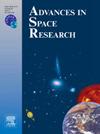利用综合农业干旱指数(IADI)加强农业干旱监测:多源遥感方法
IF 2.8
3区 地球科学
Q2 ASTRONOMY & ASTROPHYSICS
引用次数: 0
摘要
干旱严重威胁着印度的农业经济部门,造成广泛的环境退化和社会经济挑战。该研究为克服传统干旱监测方法的局限性提供了遥感技术。为了解决这一问题,本文提出了综合农业干旱指数(IADI),该指数将多个遥感衍生指标与层次分析法(AHP)相结合,用于农业干旱综合评价。IADI综合了植被健康指数(VHI)、归一化干旱指数(NDDI)和增强型植被指数(EVI)等指标,提供了适合不同耕作系统的简明评估。这项研究是在德瓦克斯瓦尔河上游流域进行的,重点关注2000年至2019年的干旱趋势。最初,干旱年份是通过降雨异常指数(RAI)确定的。随后,计算空间干旱指数并将其整合到IADI框架中。结果表明,干旱严重程度的空间差异显著,干旱影响区域年增加21.88 km2 (R2 = 0.98)。曲线下面积-受试者工作特征(AUC-ROC)验证表明,IADI的准确率为76%,优于VHI(72%)、NDDI(49%)和EVI(47%)等单项指标。这些结果凸显了IADI预测能力的提高,为实时干旱监测、资源分配和战略规划提供了有用的见解。这种方法为干旱管理提供了一个可持续的框架,帮助决策者和利益攸关方加强区域粮食安全和应对气候变化的能力。本文章由计算机程序翻译,如有差异,请以英文原文为准。
Enhancing agricultural drought monitoring with the Integrated Agricultural Drought Index (IADI): A multi-source remote sensing approach
Drought has significantly threatened India’s agro-economic sector, resulting in widespread environmental degradation and socio-economic challenges. This study provides remote sensing technology to overcome the limitations of traditional drought monitoring methods. To address this, Integrated Agricultural Drought Index (IADI), a newly proposed index that combines multiple remotely sensed-derived indicators with Analytical Hierarchy Process (AHP) for comprehensive agricultural drought assessment, is used. IADI integrates indicators such as Vegetation Health Index (VHI), Normalized Difference Drought Index (NDDI) and Enhanced Vegetation Index (EVI) to provide a concise assessment suitable for different farming systems. The study was conducted in the upper Dwarkeswar river basin focusing on drought trends from 2000 to 2019. Initially, drought years were identified using the Rainfall Anomaly Index (RAI). Subsequently, spatial drought indices were calculated and integrated into the IADI framework. The results revealed significant spatial variation in drought severity with an annual increase of 21.88 km2 in drought-affected areas (R2 = 0.98). Validation using Area Under Curve-Receiver Operating Characteristic (AUC-ROC) showed that the IADI achieved an accuracy of 76 %, outperforming individual indices such as VHI (72 %), NDDI (49 %) and EVI (47 %). These results highlight the improved predictive power of IADI, providing useful insights for real-time drought monitoring, resource allocation and strategic planning. This approach provides a sustainable framework for drought management, assisting policymakers and stakeholders in enhancing regional food security and resilience to climate variability.
求助全文
通过发布文献求助,成功后即可免费获取论文全文。
去求助
来源期刊

Advances in Space Research
地学天文-地球科学综合
CiteScore
5.20
自引率
11.50%
发文量
800
审稿时长
5.8 months
期刊介绍:
The COSPAR publication Advances in Space Research (ASR) is an open journal covering all areas of space research including: space studies of the Earth''s surface, meteorology, climate, the Earth-Moon system, planets and small bodies of the solar system, upper atmospheres, ionospheres and magnetospheres of the Earth and planets including reference atmospheres, space plasmas in the solar system, astrophysics from space, materials sciences in space, fundamental physics in space, space debris, space weather, Earth observations of space phenomena, etc.
NB: Please note that manuscripts related to life sciences as related to space are no more accepted for submission to Advances in Space Research. Such manuscripts should now be submitted to the new COSPAR Journal Life Sciences in Space Research (LSSR).
All submissions are reviewed by two scientists in the field. COSPAR is an interdisciplinary scientific organization concerned with the progress of space research on an international scale. Operating under the rules of ICSU, COSPAR ignores political considerations and considers all questions solely from the scientific viewpoint.
 求助内容:
求助内容: 应助结果提醒方式:
应助结果提醒方式:


